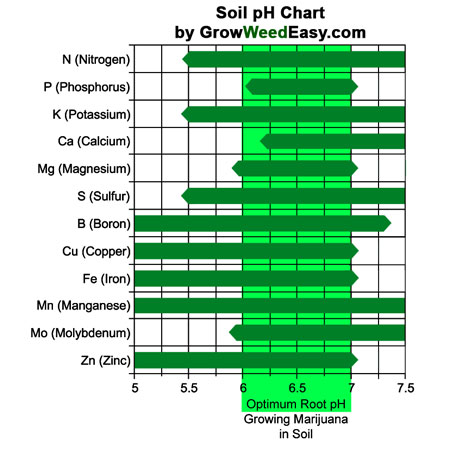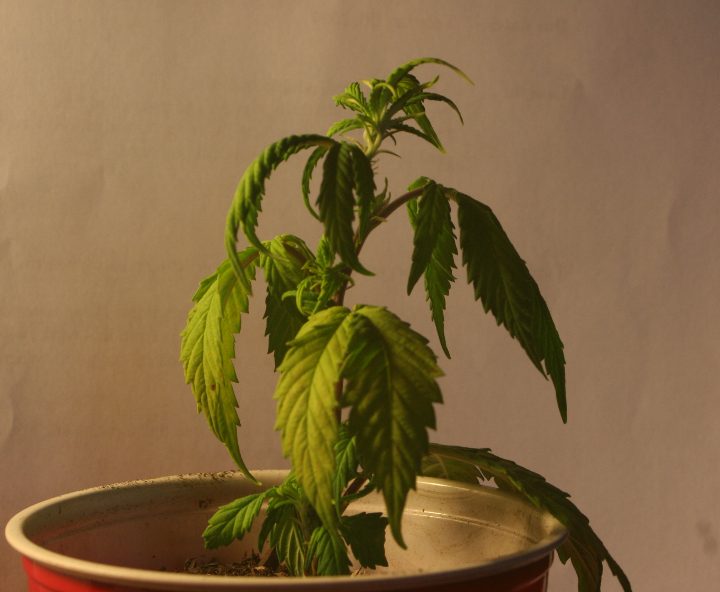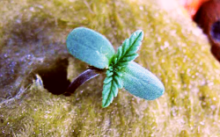You are hereHelp, My Leaves Are Dying!
Help, My Leaves Are Dying!
I hear this question all the time...
"What's wrong with my plant? The leaves are..."
-
Yellow
-
Brown
-
Grey
-
Red
-
Curling up
-
Curling down
-
Or otherwise dying
Today I will clear up the 3 most common reasons that your marijuana plant's leaves are dying...
3 Most Common Reason for Discolored Leaves
#1 Reason For Dying Leaves: Incorrect pH at the Roots
The #1 reason new growers have dying leaves is because of a pH imbalance . This is because the roots of your marijuana plants need to live in a certain pH in order to properly absorb nutrients. So the pH around the roots will actually affect which and how much nutrients can be absorbed by the plant.
Yes, that's worth repeating. You will prevent nutrient problems by checking and adjusting your pH in your marijuana grow.
That is why when new growers think they have a nutrient deficiency, often the real problem is that the pH at the roots is off, and the plant can't get access to the nutrients even though they're present.
So what is pH?
The pH scale goes from 0 to 14 and measures how "acidic" or "alkaline" a solution is. Below 7 is acidic and above 7 is alkaline. A pH of 7 is the neutral point, and pure water has a pH close to 7.
But that all sounds so complicated!
Checking and maintaining your pH is a relatively simple process that anyone can learn. I have a video below to demonstrate how easy and quick it can be to manage your pH!
Plus, the important thing is to maintain a proper range around your root zone. It's isn't critical to maintain an exact pH like 6.2 or anything like that. In fact, it's better to let the pH range slightly over time because different nutrients like different pH ranges, as you'll see in a second.
Managing pH: What Do I Need to Know?
You have several options for managing your pH. But no matter what option you choose, youwill need to invest in some way to measure pH.
You can measure pH with...
-
pH strips (not as accurate)
The process of maintaining pH looks like this:
-
Measure out the water you are going to feed your plants
-
Add all nutrients and/or supplements to the water
-
Use one of the options above to test the pH of this water
-
Use pH Up/Down or a natural pH adjustment method* to adjust the pH of your water into the proper range
-
The optimum pH for marijuana in soil is between 6.0-7.0. The optimum pH in hydro is between 5.5-6.0 (this includes growing in a soilless growing medium like coco coir). It's a good idea to allow the pH to change slightly over time within the prescribed ranges, especially in hydroponics. Take a look at the charts below to see how different nutrients are absorbed at different pH levels, so you can see why it's good to let your pH range over time.
*Natural methods to adjust pH: Add vinegar to bring pH down. Whisk water briskly (add oxygen to the water) for a minute or two to bring pH up. You can also add dolomite lime to soil in order to help bring up pH.
What Nutrients Are Absorbed Best at Which pH Range?
What If I've been following these steps, but I'm still having problems?
-
If you've been adjusting the pH of the water going in, but are still having nutrient deficiencies, check the pH of the water coming from your roots . So this means check the pH of your runoff water(the water that drains from your flower pots), or the water in your reservoir.
-
You may find that the pH is higher or lower than expected. This is why it's important to check the pH of the water coming from your roots when you're running into nutrient problems.
-
For example, let's say you watered your plants with nutrient water adjusted to a pH of 6.0, yet the runoff water is coming out with a pH of 4.0. This often happens because there is nutrient/salt buildup around the roots (usually from adding too many nutrients over a period of time). You need to remove the buildup. A common way to remove salt buildup is to flush the plant with about 3x as much plain, pH'ed water as normal. Then go back to your normal feeding schedule (make sure you check the runoff pH again afterwards, to make sure that your flush worked).
-
In hydroponics where the roots are growing in water, it is common for the pH to rise over time. This is partially because oxygenating your water (for example using an airstone) actually raises the pH. This is why it's important to keep checking the pH until you've grown familiar with how the pH tends to play out with your system and your water/nutrients.
Wait, why do I need to check the pH of my run-off water?
The pH of your soil or potting mix can fluctuate as nutrients/salts begin to build up. This happens most often when you are regularly feeding more nutrients than your plant can use.
Checking the pH of your run-off water is an important step to diagnose problems with the pH around your plant root zone. This step is especially important for new growers and those who are having issues with nutrient deficiencies.
If the runoff pH is much higher or lower than expected, chances are you have unused nutrients or salt build-up near the roots that are raising or lowering the pH of your root zone.
When this happens, you can remove this buildup by flushing your soil or soilless mix with about 3 times as much pH'ed water as the volume of your container. You can also flush your plant to remove extra nutrients if you've over-fertilized your plants and they're showing signs of nutrient burn.
This will wash away the buildup and help "reset" the pH of your root zone back to the proper level.
Some growers choose to flush their plants every 3-4 weeks regardless of whether they notice problems to prevent buildup, though this is usually unnecessary unless you are chronically overfeeding with nutrients.
After someone has been growing the same strain of marijuana, in the same medium, with the same nutrient solution, etc. for a while, chances are they will become very familiar with their growing style and won't need to check the pH of their runoff water unless they notice problems.
Show Me Step-By-Step: How Do I Check the pH of My Water?
Read full cannabis pH tutorial here:
http://www.growweedeasy.com/ph
NOTE: The the blue and orange pH up/down bottles you see at hydroponic growing stores are not designed for organic growing. While some growers believe it is okay to add pH up/down in small amounts after you've mixed your nutrients into your water, other growers feel this may kill the microorganisms that make organic growing so effective.
In my experience, this hasn't been a big problem for me. I have personally grown dank organic marijuana while using pH up/down as my primary source of adjusting pH, but it is possible that I may have killed some beneficial organisms in the soil along the way.
If you're an organic gardener and worried about using pH Up/Down, there are also natural ways to adjust the pH of your water.
Add vinegar to bring pH down. Whisk water briskly (add oxygen to the water) for a minute or two to bring pH up.
If your organic soil tends to be too acidic (pH is too low), which is a common problem when growing organically, you can also mix some dolomite lime in with your soil to slightly raise the pH and acts as a buffer to help keep the pH naturally stable. Plus dolomite lime naturally adds additional calcium and magnesium to your soil.
A cool fact about pH:
- The type of nitrogen used in a nutrient system has the biggest effect on how that nutrient will affect the pH of your water.
- Using this knowledge, a smart grower could buy or mix up nutrients based on the current pH levels of their water so that their nutrients auto-correct the pH.
Ok, you have successfully made sure you've corrected the pH, and you're still seeing dying leaves, or leaves with problems.
Chances are you have a watering/root problem.
When growing in soil or a soilless growing medium like coco coir, this is usually caused by poor drainage, or over/under watering.
To properly water your marijuana plant every time, use this technique:
Every time you water, add enough that about 20% extra runoff water has drained out the bottom (if you don't have drainage holes, or if water isn't draining, this needs to be fixed immediately or you will run into lots of other problems).
After you've watered your plants with 20% extra runoff, then don't water them again until the growing medium is dry enough to stick your finger in to about your first knuckle without feeling moisture.
In hydroponics where you're growing with your roots directly in water , a root problem doesn't result from over/under watering, since you don't water your plants.
The problem in hydro usually results when plant roots start "drowning" because they can't get access to enough dissolved oxygen in the water.
The way to fix this is to oxygenate your water with an air stone, or otherwise get more oxygen to your plant roots.
In both soil and hydro, you can also see signs of root problems because of a condition known as "root rot." This condition will give you brown, mushy, smelly roots.
Root rot is often the result of bad watering practices, high temperatures, or poor drainage, but sometimes root rot can appear out of nowhere.
When this happens, a great cheap supplement that seems to completely decimate root rot is Aquashield. There are also other root supplements that are more expensive such as Great White and Subculture B, but I've always had the best results with the much cheaper Aquashield.
#3 Reason For Dying Leaves: Nutrient Problem
Ok, you've ruled out the #1 and #2 most common reasons for dying leaves. You may actually have a nutrient problem.
This picture guide should help you figure out exactly which nutrient problem you have:
http://growweedeasy.com/marijuana-symptoms-pictures
What Do I Do if None of This Works?
Jump to...





